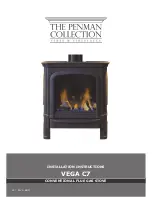
4.0 POSITIONING THE APPLIANCE
4.1 Installation of the flue liner
For optimum performance we recommend that the chimney is lined with a 100mm diameter stainless steel gas
flue liner. Proprietary terminals must comply with BS715 or BS1289. Any terminal or termination must be
positioned in accordance with BS5440 Part 1 to ensure that the products of combustion can be safely dispersed
into the outside atmosphere. For decorative purposes, the gas flue liner may be sleeved with 125mm diameter
vitreous enamelled flue pipe.
4.2 Connecting the gas lines
You can determine where the gas pipes will be placed depending on the positioning of the appliance. Ensure
control equipment is not twisted during installation and there is no excessive tension. Accessibility of various
connection points in relation to components need to be maintained. After installation, check the connections for
gas leakage. Use a 3/8” gas tap in the main gas supply.
Ensure the gas pipes are dirt-and sand-free.
The
gas connection should only be done without any excessive tension in the tubes etc. This prevents any damage
occurring to the gas control equipment.
4.3 Preparation and installation (see Appendix 2 - page 21)
Remove the packaging and check the unit for possible damage.
Place the unit on a stable surface.
Do not place the unit on its back or side!
Place the unit near to the installation location.
Lift the cast iron lid from the unit and carefully place aside.
(1)
Locate the four wing bolts on the rear face of the front cast iron panel and unscrew
(2 & 3)
. Carefully
remove the cast iron front panel to gain access to the gas appliance - take care when removing as this
component is heavy.
Next, open the door of the gas appliance and take all the packaged components out— check to make sure
they are not damaged or broken.
Fit the ceramic log set (see section appendix 3 - page 22).
Replace the cast iron front panel and secure with the four wing bolts.
Replace the cast iron lid and position the unit at the installation location.
Adjust the feet on unit to maintain a level installation.
4.4 Fitting the ceramic log set (see Appendix 3 - page 22)
First place the ceramic log part on the burner as shown.
Spread the “fusilli” (spiral-shaped ceramic material) around the ceramic log part and evenly over
the burner so that the burner is just covered.
Spread the glowing material (lava granules) and spread them over the burner plate.
Pay attention to the air supply
. Glowing embers can be placed here and there as decoration.
Place the ceramic wood blocks in the correct order as shown on Appendix 4.
Place the logs carefully. Incorrect placement can seriously affect the flames or cause a malfunction of the
burn process (sooting).
Slot/opening between burner and mesh deco plate must be kept free of glowing material
Close the door.
4.5 Spillage test
The appliance must be fully installed before the spillage test is performed.
For instructions on how to ignite the appliance please see sections 1 and
2 of this booklet.
Close all doors and windows of the room in which the appliance is
located.
Ignite the main burner and operate on the highest setting.
Use a smoke match and hold underneath the draught diverter
(located at the rear of the appliance) at the position where the
TTB sensor is located. If the smoke is drawn into draught diverter
the test is successful. If it is not there is spillage and the appliance
should not be used until this is rectified.
PAGE 8
IMPORTANT:
Make sure the pilot light remains unobstructed.
LOCATED UNDER HERE
HOLD MATCH HERE
REAR OF APPLIANCE




















